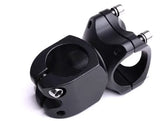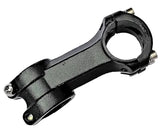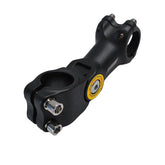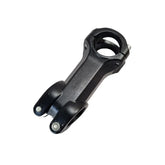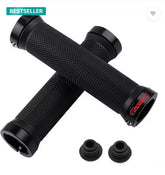Filter
15 results
15
- 10
- 15
- 20
- 25
- 30
- 50
Best selling
- Featured
- Best selling
- Alphabetically, A-Z
- Alphabetically, Z-A
- Price, low to high
- Price, high to low
- Date, old to new
- Date, new to old
Sort
Sort by:
- Featured
- Best selling
- Alphabetically, A-Z
- Alphabetically, Z-A
- Price, low to high
- Price, high to low
- Date, old to new
- Date, new to old
-
Suitable for Mountain bike, fixed gear and other bicycles. Stiff and sturdy, ensure long lifetime of using. Perfect design makes the handlebar adjust in a perfect position. The 31.8mm handlebar diameter works nicely with modern bars. Easy installation, just connect up the original front...
- Rs. 599.00
Rs. 799.00- Rs. 599.00
- Unit price
- / per
-
Bicycle Stem for Threaded Fork. Product Key Features Part Type: Bicycle Stem Stem Type: Quill Clamp Diameter: 31.8 mm / 25.4 mm Material: Steel Color: Black Compatible Bike Type: All MTB and Hybrid bicycles with Riser handlebars Suitable for Threaded Fork Only Select size...
- Rs. 230.00
Rs. 800.00- Rs. 230.00
- Unit price
- / per
-
SpecsLength : 5.5 inch Weight : 154 gLockring: AlloyGrip: SiliconeSuitable ForHybrid & City BikeMTBCompatibility CheckHandlebar diameter at the edges should be compatible for the grips
- Rs. 1,199.00
Rs. 1,500.00- Rs. 1,199.00
- Unit price
- / per
-
Colour BLACK Brand Generic Material Aluminium Bike Type Road Bike Cycling, Mountain Bike, BMX Bike Manufacturer IHI EXPORTS About this item ? Front Fork Stem Diameter: 28.6mm (1-1/8"), Handlebar Diameter: 31.80mm; Length: 100mm center to center. Please check the size of the handlebars before...
- Rs. 899.00
Rs. 1,499.00- Rs. 899.00
- Unit price
- / per
-
- Rs. 599.00
Rs. 699.00- Rs. 599.00
- Unit price
- / per
-
Soft comfortable and easy to fit on any Bicycle handle bar. Designed for filtering vibrations and improving comfort. Length: 125 mm Long life Sport Practices : BMX, URBAN CYCLING, HYBRID BIKES, MOUNTAIN BIKES
- Rs. 100.00
Rs. 200.00- Rs. 100.00
- Unit price
- / per
-
Soft comfortable and easy to fit on any Bicycle handle bar. Designed for filtering vibrations and improving comfort. Length: 125 mm For an unmatched premium style statement. Long life, hand stitched. Sport Practices : BMX, URBAN CYCLING, HYBRID BIKES, MOUNTAIN BIKES
- Rs. 199.00
Rs. 299.00- Rs. 199.00
- Unit price
- / per
-
Fit any standard straight handlebar bicycle or handlebars. It absorbs shock and relieves your fatigue and hands pressure for long rides. Clamp design is easy to install and stays in place. Keep your grips tight and secure. LOCK-ON - Each grip has a lock-on...
- Rs. 699.00
Rs. 799.00- Rs. 699.00
- Unit price
- / per
-
Fit any standard straight handlebar bicycle or handlebars. It absorbs shock and relieves your fatigue and hands pressure for long rides. Clamp design is easy to install and stays in place. Keep your grips tight and secure. LOCK-ON - Each grip has a lock-on...
- Rs. 699.00
Rs. 799.00- Rs. 699.00
- Unit price
- / per
-
Bicycle Stem Adjustable (Alloy) Adjustable Stem to get into the perfect riding posture on your bike. Stem for Hybrid & MTB Bikes Length: 105mm Suitable Handle Bar Diameter center : Ø 31.8 mm Material: Alloy 4 Bolt Type Adjustable Angle 60° : (40° degree upward...
- Rs. 1,699.00
- Rs. 1,699.00
- Unit price
- / per
-
Bicycle Stem (Alloy) for Threadless Fork Technical Specification : Length: 80mm Material: Alloy 4 Bolt Type Angle 15° Suitable for Bicycle handlebar centre diameter : Ø 31.8 mm Please Note - This part comes in Loose OEM Packaging.
- Rs. 399.00
- Rs. 399.00
- Unit price
- / per
-
- Rs. 300.00
Rs. 999.00- Rs. 300.00
- Unit price
- / per
-
680 MM Curved Handle Bar Steel
- Rs. 1,000.00
- Rs. 1,000.00
- Unit price
- / per
-
680 MM Curved Handle Bar
- Rs. 357.00
- Rs. 357.00
- Unit price
- / per
-
125 MM Palm Support Handle Grip
- Rs. 313.00
- Rs. 313.00
- Unit price
- / per



